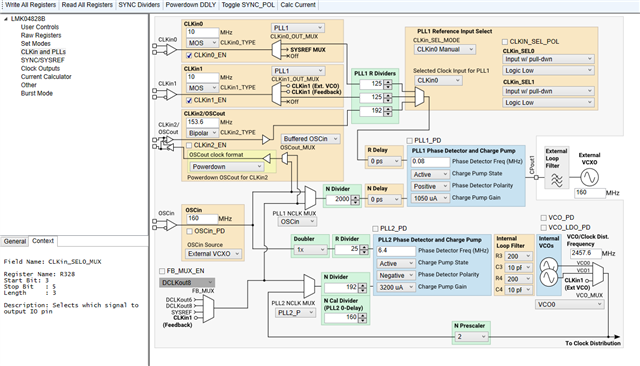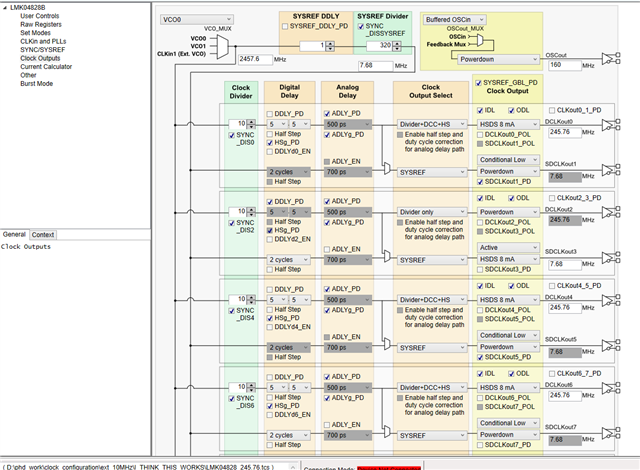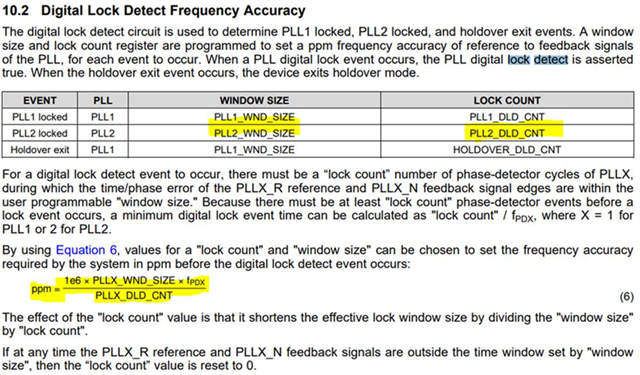Other Parts Discussed in Thread: LMX2594
Hi Team,
Good day. I am posting this inquiry on behalf of the customer.
"I am working on RFSoC4x2 (Gen3 XCZU48DR) with PYNQ version 2.7.0 and vivado 2020.2
My primary requirement is to configure LMK04828 chip on board to take external 10MHz ref clock input and produce 245.76MHz to feed to LMX2594 chip which, in turn, is generating 409.6MHz. I did generate .tcs (and .txt) configuration file for the same and added the corresponding .txt file (i.e. LMK04828_245.76.txt) in xrfclk package in JupyterNotebook environment (path: /usr/local/share/pynq_venv/lib/python3.8/site-packages/xrfclk). Also, I am setting these clocks using command
xrfclk.set_ref_clks(lmk_freq=245.76,lmx_freq=409.6)
Now the problem is- My design is working even when I am not feeding the external clock to the board which means it’s definitely taking driving_clock from another input pin and I can’t figure out which one or there's something which I am missing here.
Could you please guide and help me resolve this issue?
Attached is my config file (.tcs) and hex register (.txt) file for reference and also some snaps which might be helpful for you to understand the issue more clearly. "


R0 (INIT) 0x000090
R0 0x000010
R2 0x000200
R3 0x000306
R4 0x0004D0
R5 0x00055B
R6 0x000600
R12 0x000C51
R13 0x000D04
R256 0x01006A
R257 0x010155
R258 0x010255
R259 0x010301
R260 0x010422
R261 0x010500
R262 0x010673
R263 0x010703
R264 0x01086A
R265 0x010955
R266 0x010A55
R267 0x010B00
R268 0x010C22
R269 0x010D00
R270 0x010EF0
R271 0x010F30
R272 0x01106A
R273 0x011155
R274 0x011255
R275 0x011301
R276 0x011422
R277 0x011500
R278 0x011673
R279 0x011703
R280 0x01186A
R281 0x011955
R282 0x011A55
R283 0x011B01
R284 0x011C22
R285 0x011D00
R286 0x011E72
R287 0x011F03
R288 0x012074
R289 0x012155
R290 0x012255
R291 0x012301
R292 0x012422
R293 0x012500
R294 0x012670
R295 0x012733
R296 0x01286A
R297 0x012955
R298 0x012A55
R299 0x012B00
R300 0x012C22
R301 0x012D00
R302 0x012EF0
R303 0x012F30
R304 0x01306A
R305 0x013155
R306 0x013255
R307 0x013301
R308 0x013422
R309 0x013500
R310 0x013673
R311 0x013703
R312 0x013800
R313 0x013903
R314 0x013A01
R315 0x013B40
R316 0x013C00
R317 0x013D01
R318 0x013E03
R319 0x013F02
R320 0x014009
R321 0x014100
R322 0x014200
R323 0x014331
R324 0x0144FF
R325 0x01457F
R326 0x01461B
R327 0x01470A
R328 0x014802
R329 0x014942
R330 0x014A06
R331 0x014B26
R332 0x014C00
R333 0x014D00
R334 0x014EC0
R335 0x014F7F
R336 0x015011
R337 0x015102
R338 0x015200
R339 0x015300
R340 0x01547D
R341 0x015500
R342 0x01567D
R343 0x015700
R344 0x0158C0
R345 0x015907
R346 0x015AD0
R347 0x015BDA
R348 0x015C20
R349 0x015D00
R350 0x015E00
R351 0x015F0B
R352 0x016000
R353 0x016119
R354 0x016244
R355 0x016300
R356 0x016400
R357 0x0165A0
R369 0x0171AA
R370 0x017202
R380 0x017C15
R381 0x017D33
R358 0x016600
R359 0x016700
R360 0x0168C0
R361 0x016959
R362 0x016A20
R363 0x016B00
R364 0x016C00
R365 0x016D00
R366 0x016E13
R371 0x017300
R386 0x018200
R387 0x018300
R388 0x018400
R389 0x018500
R392 0x018800
R393 0x018900
R394 0x018A00
R395 0x018B00
R8189 0x1FFD00
R8190 0x1FFE00
R8191 0x1FFF53
Please help to advise. Thank you for extending your support.
Kind regards,
Marvin



